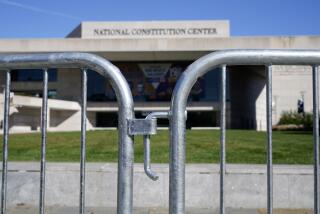Armed India Can Help Stabilize Asia
In May, 1998, India conducted five nuclear tests. More than two years later, the United States, with a record of 949 nuclear tests during the five decades since Hiroshima, is still enforcing punitive economic sanctions against New Delhi, poisoning the entire relationship between the worldâs two largest democracies.
President Clinton should quietly bury this self-defeating policy when he meets with Prime Minister Atul Behari Vajpayee at the White House this week. Pressuring India to reverse its commitment to develop nuclear weapons merely strengthens Indian hawks who oppose closer relations with Washington and favor an all-out nuclear buildup that would stimulate nuclear arms races with China and Pakistan.
The United States should accept the reality of a nuclear-armed India as part of a broader recognition of its emergence as a major economic and military power. Such a shift would remove the last major barrier blocking a rapid improvement in Indo-U.S. relations. President Clinton has kept up the pressure on India to forswear nuclear weapons despite the fact that all sections of Indian opinion strongly favor a nuclear deterrent.
Instead of persisting in a futile effort to roll back the Indian nuclear weapons program, the United States should seek to influence the current debate in New Delhi over the size and character of the nuclear buildup. A more relaxed relationship with New Delhi would facilitate U.S. cooperation with moderate elements in the Indian leadership who favor nuclear restraint.
A U.S. policy focused on nuclear restraint rather than nuclear rollback should not only seek to minimize the number of warheads but also to keep them under civilian control and to limit the frequency of missile tests. Other key U.S. goals should be to get India to sign the Comprehensive Nuclear Test Ban Treaty and to formalize de facto Indian restrictions on the export of nuclear technology.
Moderate elements in New Delhi are sympathetic to many of these objectives but need U.S. quid pro quos to make them politically attainable. For example, the continuation of sanctions makes it impossible for the Indian government to sign the test ban without appearing to surrender to foreign pressure. Equally important, the sanctions have blocked $3 billion in multilateral aid credits for power projects and other economic development priorities.
Together with the removal of sanctions, the U.S. should greatly reduce the blanket restrictions on the transfer of dual-use technology that were imposed after the 1998 tests. These restrictions cover many items with little relevance to nuclear weapons.
The most important U.S. quid pro quo would be the relaxation of the existing U.S. ban on the sale of civilian nuclear reactors badly needed by India to help meet its growing energy needs. Indians find it galling that China is permitted to buy U.S. reactors, while India is not.
The reason for this blatantly discriminatory policy lies in legalistic hair-splitting in the 1968 Nuclear Non-Proliferation Treaty (NPT). Since China had tested nuclear weapons in 1964, it was classified as a ânuclear weapons stateâ under the treaty. As such, Beijing was eligible to sign the NPT, along with the other powers then possessing nuclear weapons, the United States, Russia, Britain and France.
All other states were barred in perpetuity from the nuclear club and asked to forswear nuclear weapons formally by signing the treaty. India branded the NPT as discriminatory and refused to sign. Now it would like to sign as a nuclear weapon state but the U.S. will not permit it.
The NPT itself does not bar its signatories from providing nuclear technology to non-signatories such as India, However, the U.S. Congress went beyond the NPT with a law stipulating that non-signatories cannot receive U.S. nuclear technology even if they accept International Atomic Energy Agency, or IAEA, safeguards on its use, which India is willing to do. This legislation even bars the U.S. from helping India to make its nuclear reactors safer.
Significantly, Hans Blix, the respected former IAEA director who now heads the U.N. arms inspection mission to Iraq, has urged that the ban on civilian nuclear sales to both India and Pakistan be lifted if they are willing to make two major concessions: signing the test ban and agreeing to freeze their stockpiles of weapons-grade fissile material at present levels.
âThere is nothing in the NPT that would stand in the way of such an arrangement,â Blix noted at a Stockholm seminar, and as matters stand, âIndia and Pakistan are most unlikely to discard whatever nuclear weapons capacity they possess. There is even a clear risk of a race between them to increase fissile material stocks.â
The United States has been pushing India to join in a multilateral moratorium on fissile material production but without offering clear incentives. Blix has proposed a more realistic approach. U.S. policy should be based on a tacit recognition that a multipolar Asian balance of power in which India possesses a minimum nuclear deterrent will be more stable than one in which China enjoys a nuclear monopoly.
More to Read
Sign up for Essential California
The most important California stories and recommendations in your inbox every morning.
You may occasionally receive promotional content from the Los Angeles Times.










